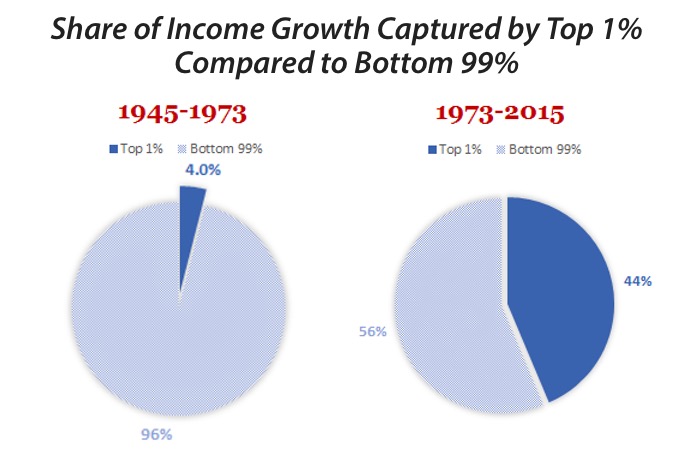We’ll start off with a chart I found on the Colorado Center on Law & Policy website, dated July 2018:

From that same report:
Income inequality in Colorado has reached historic highs in recent years according to a new report released today by the Economic Policy Institute (EPI). The top 1 percent of earners in Colorado captured 44 percent of all income growth in the last 45 years… The benefits of economic growth in our state have mostly accrued to the very top of the income spectrum since the 1970s. Rising inequality decreases social mobility of lower and middle class families, and reduces growth for Colorado’s economy as a whole…
I’m thinking about this chart, because a County employee sent me a link to an article in The Colorado Sun, the online newspaper created a year ago by a bunch of ex-Denver Post reporters. The Sun story discusses economic growth in Colorado and the ‘Enterprise Zone’ tax breaks that our state government provides to wealthy corporations in the name of ‘economic development.’
From that article by reporter Brian Eason:
An interim study committee met for the first time this summer to begin reviewing the more than $6.6 billion in annual tax breaks on the state’s books. In that context, the Enterprise Zone, worth anywhere from $40 million to $80 million annually in recent years, is a drop in the bucket.
But no matter their size, the sheer volume of the tax credits being handed out begs an important question that state lawmakers are just now starting to consider: Why?
“A question this committee needs to ask themselves is ‘Does Colorado really need to be playing these types of games?’ ” Katherine Loughead, a policy analyst at the conservative Tax Foundation, told lawmakers at the committee’s first hearing in July. “Colorado is thriving.”
Between 2013 and 2018, the State of Colorado handed out at least $223 million in Enterprise Zone tax credits. The top recipients? Suncor Energy ($11.2 million), United Airlines ($11.1 million), Northern Colorado Wind Holdings ($8.8 million), Anadarko Petroleum ($8.7 million), Leprino Foods ($8.5 million). Also in the list of top recipients are BSNF Railway, Xcel Energy, Whiting Petroleum, Encana Oil & Gas, Kinder Morgan, Walmart, Verizon Wireless, and CenturyLink.
According to Mr. Eason’s article, Colorado governor Jared Polis has convened a six-member committee — of Senators and Representatives, plus a staff of five — to look into the various tax breaks provided to corporations, farmers and ranchers.
Mostly, to corporations.

Are Enterprise Zone tax breaks working to help grow local economies in rural Colorado, for example? Or are they merely another form of “corporate welfare”? A couple of issues make this exploration especially challenging.
If you ask the corporations themselves whether Enterprise Zone tax breaks are necessary, they will typically respond to the effect that, “We wouldn’t even be operating in this podunk one-horse town (or county) without some type of tax incentives…” And policy makers are hard pressed to determine if the corporations are telling the truth. If the Enterprise Zone program were eliminated, would these corporations discontinue operating in rural Colorado? Only one way to find out. Eliminate the tax credits and watch what happens.
But that might be easier said than done. Because these corporate subsidies are delivered as “tax credits” rather than as “grants” or other types of subsidies, eliminating the tax credit could conceivably be seen — legally — as a “tax increase.” Under the Taxpayers Bill of Rights (TABOR) any tax increase in Colorado is supposed to be approved by the voters.
From Mr. Eason’s Sun article:
State Sen. Dominick Moreno, a Commerce City Democrat who serves on the study committee, said he thinks the program has had “some level of success” in spurring development in distressed areas. “But more so,” he says, “I think you just have big corporations in economically depressed areas taking” tax credits…
… [Governor] Polis has proposed replacing corporate tax breaks with an across-the-board income tax cut for everyone. But that, too, has never been tested in court. It would effectively raise taxes on some taxpayers in order to reduce them for others.
“I think there may be litigation regardless of which direction we decide to go,” Moreno said.
I find this discussion fascinating at this particular moment in time, because two wealthy developers recently approached the Pagosa Springs Town Council, asking for what essentially amounts to $80 million in local “tax credits.”
The developers — the Springs Resort and BWD Construction — want the Town to create its own “tax credit zone” using an Urban Renewal Authority and Tax Increment Financing (TIF) to pay the developers for the infrastructure needed to develop about 27 acres of vacant land just south of the Springs Resort.
The development, we are told, might include a new hotel complex, several retail store locations, restaurants, a huge office building, and maybe 250 new homes and condos.
The development, we are told, will never happen without $79 million in TIF tax subsidies distributed to the developers.
As we all know, money doesn’t grow on trees. And tax revenues don’t grow on trees. Someone pays the taxes, and then elected and appointed government officials figure out how to spend it. What happens when all of the local taxes, from a fancy new development, go back into the pockets of the developers?
Is this a viable plan for a thriving community?
